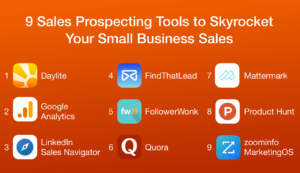If you want to close more deals, outline your sales process steps to streamline the way your leads move through your pipeline.

So what’s a sales process? It’s a structured approach to closing more deals and closing them faster. A sales process is a set of repeatable steps that a business or salesperson follows to take a potential client from the early stage of interest to a closed deal.
With clearly defined sales process steps, you can prevent missing any tasks, make it easier to train when you’re ready to hire a new salesperson, and over time, understand what’s working and what’s not. This allows you to tweak the process, accurately forecast your sales, and close more deals.
Problems with not having a sales process
- Forgetting to follow up and missing out on business
- Inconsistent client experience
- Not knowing what’s working and what isn’t
- Difficulty training new salespeople
- Inability to forecast
Benefits of having a sales process
- Streamlined process so no steps are missed
- Increase close rates
- Improve client experience
- Identify what’s working and what’s not so you can improve the process
- Accurately forecast revenue
- Get new hires onboarded faster and with ease
Not sure where to start when it comes to your own sales process? We’ve got you covered!
Sales process steps
Below, we’ll walk you through typical sales process steps to help you build your own. Every business, client, and service is unique, so depending on yours, you may need to add additional steps. Use this as a guide to get you started on the right path!
Sales process step 1: Inquiry

This is your first interaction with a potential client. Your new lead may have met you at a networking event, filled out a form on your website, or contacted you on social media – regardless of how you came in contact, they are interested in your services!
‼️Pro tip: The obvious step is capturing your lead’s name and contact information, but capturing details about them, their needs, what they’re looking for or are interested in, etc. is a very crucial step. In order to follow up effectively, personalizing the experience for your lead by using these details will make you more likely to hear back. You can use a spreadsheet to track details like this, but ideally, a CRM will make it easiest to track everything from contact details to every follow-up and interaction with your new lead – all while keeping it in one place.
Sales process step 2: Qualify

Now that you’ve captured all the details about your new lead, you need to qualify and identify their needs. By qualifying your lead, you can understand if they’re the right fit for your services – is what you’re offering going to help this potential client? What problem are they looking to solve? By qualifying, you’ll know which leads are worth pursuing and which prospects are not your ideal client. You will later be able to use this information to track trends and spot where most of your right-fit leads are coming from. Using this data, you can double-down and invest more time in things that are working.
Not every lead you come across will be the right fit for your business, and that’s okay. It’s important to also track these wrong-fit leads regardless. This way, you can find out what could be attracting leads that don’t align with what you’re offering. Do you need to tweak your marketing message? Are other clients referring you the wrong type of lead? For example, if you have someone referring you wrong-fit leads, you can touch base with them to educate them on what kind of client is the right fit for you and keep leveraging their referrals.
‼️Pro tip: Leverage the language you’re hearing from the right-fit leads when they talk about problems they’re looking for your help to solve. Take note of trends – do your leads always mention a particular issue, or most commonly use a certain word or phrase to describe why they need your help or what they’re looking for? By being aware of this, you can later use these words and phrases in your marketing materials, like your website or social media. You’re speaking directly to your potential clients through your marketing, so using their own language is vital.
Need more marketing help? On our YouTube channel, we share 7 marketing ideas for small businesses that won’t cost a lot of money or require a marketing degree!
Sales process step 3: Offer

After you’ve qualified your lead and you know you’re the right fit to provide the solution to their needs, you can now make your offer. Depending on your business, this may be a quote, an email with pricing details, or a phone call discussion. Either way, you should be on the ball! Send the offer to your lead soon after you’ve assessed their needs and qualified them as a good-fit lead. Sending your offer while they are actually interested will make them more likely to move forward.
‼️Pro tip: Ensure your offer is clear so your lead can understand it – remember, you’re asking them to spend their money, so make it transparent. For example, a quote should be detailed to include line items that break down your services and expenses clearly. Your lead should be able to understand each line item and be left without any questions about what they’re paying for. Often, businesses send a quote with one line item of total cost and don’t break down the details. When a prospect sees this, they may think, wait, why so expensive? What am I paying for? If you break it down for them, they often have an easier time digesting the cost because they can actually see how all the steps or stages of your service adds up. Additionally, this comes with the added benefit of preventing a time-consuming back and forth of questions and answers for both of you, making the experience more positive and painless.
Sales process step 4: Follow up (and follow up and follow up…)

Once you’ve sent your offer, it’s time to follow up. Does your lead have questions you haven’t answered yet or need any clarification? Are you up for negotiation? Whether via email, call, or meeting, make sure you follow up 1-2 days after sending your offer to strike while the iron is hot. The follow-up stage in the sales process doesn’t mean you just follow up once. If your lead doesn’t reply, don’t just wait – follow up again and remain proactive. End any conversations you have with a call to action – this is a clearly defined next step that tells your lead what they have to do. You may have a back and forth over pricing, need to answer more questions, or simply just need to check in to find out where the lead is at in their decision. Either way, expect to follow up multiple times – 80% of sales require 5 follow-ups after the initial meeting.
‼️Pro tip: However you do it, remember that it is your responsibility to follow up – don’t wait for your lead to make the move on their own. Now is when they are interested and if you don’t stay top of mind, they can easily move on or get distracted by other things, including competitors. If you struggle with what to say in your follow-ups, try our guide on how to write a warm follow-up email. Using the details you learned about your lead in step 1 of the sales process will make it easier for you to make meaningful connections each time you reach out, helping you stand out among everything else going on in your prospect’s life.
Sales process step 5: Close

If your lead is ready to move forward:
You made it to step 5! You’ve now followed up and made any necessary adjustments to your offer. At this last sales process step, ideally, your lead has now become a client. Now the real work begins! You will likely have several action items to check off your list to completely close the deal. What do you need to do to formally mark the deal as won? For example, you may have a contract you need them to sign and send back to you. Maybe you have a retainer they need to send you. You may need them to finalize or confirm upcoming dates related to your service. All of this could take several follow-ups on its own. Whatever the tasks needed for your specific business, make sure to cross your t’s and dot your i’s to completely finalize the deal as won.
If your lead isn’t ready to move forward:
You may get to step 5 and feel like you’re close to winning the deal, but then you don’t hear back or your lead changes their mind. This is certainly frustrating and can make you feel defeated. It’s important to keep in mind that hearing “no” doesn’t mean “no” forever. You still want to stay in touch with your lead – even if they went with a competitor, you can follow up in a few months to ensure that it’s working out for them. Maybe your lead finds that they hired someone and a month or two into the project they’re regretting it. You checking in with them could make them re-think their decision and if they’re happy with how things are working out. Ask them how things are going or if they need anything from you.
In the meantime, you’ll still need to track this and identify what prevented you from turning your lead into a client. Was it your pricing, the experience you provided or were they just not the right fit for your business? By tracking your close rates and reasons you’re losing business over time, you can start to identify areas of opportunity.
‼️Pro tip: We have all experienced buyer’s remorse. As soon as you’ve committed, you start to feel the jitters. To avoid this with your new client, delight them right off the bat. First, send a thank-you of some kind. This can be a thank-you email, a small gift, or a PDF thanking them and reiterating what you can do for them with examples of or testimonies about your work. Once that’s done, promptly begin the next steps of getting your project or service started. This will impress them right away and make them feel confident about making the decision to choose you.
Optimizing your sales process
Now that you have your sales process steps defined, you can go over it and look for what’s working and what’s not working. Take a step back and look for ways to optimize your sales process steps even further. Ask yourself the following questions:
- Where are the potential bottlenecks? What can you do to remove them?
- What steps are taking too long? Why?
- What steps in the process can be automated?
- What are the friction points in the sales process steps?
Now, answer these questions a second time as though you were your ideal potential client. It’s very important to be looking at and answering each question from the prospect’s perspective. A lot of businesses look at it from their own perspective, but while something may seem clear and easy to you, it may not to your lead. You might feel that you get your service finished it record time compared to your competitors, but to your lead, will it feel like it takes ages? If you have a website, fill out your own form or read your own copy as though you were a prospect – is it easy and clear? Where did you get stuck?
You will always be able to tweak your sales process steps over time, so don’t get too bogged down with trying to perfect every detail. You will come across different scenarios with every new lead that will give you insight into ways you can make adjustments.
‼️Pro tip: A CRM makes it easier to report on the data you’ll be collecting throughout your sales process steps so you can make improvements over time. If you’re looking for a tool to track your sales process then you may want to check out Daylite! Daylite is a Mac CRM that includes built-in project management. If winning the deal with your sales process steps is just the beginning, Daylite will help you track all the moving pieces of the service you’re providing for your new client, from calls and emails to documents and appointments! If this sounds like something you need, try us out for free.
About the author:
Kristie Holden is an online marketing consultant. She helps startups get more leads by clarifying their message and creating a marketing strategy to attract and convert their ideal client. Connect with her on Instagram.



